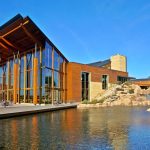Spektral Quartet
The Spektral Quartet gives a smashing finale to the Unruly Music Festival.

The Spektral Quartet, L-R: Violinists Aurelian Fort Pederzoli and Austin Wulliman, violist Doyle Armbrust and cellist Russell Rolen. Photo courtesy of Spektral’s website.
Unruly 3: Once in a while, a concert amazes, defies description and sticks in the mind for years. The Spektral Quartet, in residence at the University of Chicago, played such a concert Saturday night to close the autumn edition of the Unruly Music Festival at Marcus Center Vogel Hall.
George Crumb’s Black Angels was the draw for me. Completed on the auspicious date of Friday, March 13, 1970 at the height of the Vietnam War, Black Angels remains fresh, audacious and spellbinding over 42 years after. Crumb’s scores from this time are arguably some of the most original works of the 20th century. Crumb immersed the audience in exotic, even otherworldly landscapes, via his compositional alchemy. The Spektral Quartet delivered a jaw-dropping performance of this seminal work. People who call themselves serious lovers of music should perform extended penance for missing this.
British composer Thomas Adès’ Arcadiana might have been the most conventional piece on the program, but that’s like calling a painting by Mark Rothko more conventional than one by Jackson Pollock or Willem de Kooning on the basis of brush technique. Adès seven-movement quartet covers an extraordinary range. He references a wide variety of musical traditions, to match the polyglot nature of the titles of the movements, which are Italian, French, German, Spanish and English. In certain respects, Arcadiana recalls some of John Zorn’s compositions from the 1980’s. But outrageousness, contrast and disconnected juxtapositions fascinated Zorn. Adès connects disparate materials and styles, and we take delight in the unexpected parallels among seemingly unrelated thoughts.
The Spektral Quartet deviated from the printed program by inserting Christopher Fisher-Lochhead’s I never learnt to share between the Thomalla and Adès compositions. Fisher-Lochhead drew upon James Blake’s song of the same name. This brief work served as a palate-cleanser between the more substantial Albumblatt and Arcadiana.
The Spektral Quartet, comprising violinists Aurelien Fort Pederzoli and Austin Wulliman, violist Doyle Armbrust and cellist Russell Rolen, will return to Milwaukee for a concert on April 6, featuring works by Elliott Carter and composition students at the University of Wisconsin-Milwaukee. Mark that date.
On night two of the Unruly Music Festival, Sarah Plum offered an evening of contrasts. Advance billing as a Friday evening of music for violin and electronics, but only three of the seven pieces involved electronics. One of the remaining four pieces was a duet for for violin and cello, and the remaining pieces were for unaccompanied violin. Plum and guest performers Jonathan Ruck and Chris Burns were consistently stunning as they played seven works that not only demanded conventional virtuosity but also great skill in unconventional techniques.
Ben Fuhrman’s Sirens was a fitting opener. Fiery gestures, eminently suited for the violin, developed in fascinating and organic ways as Sirens went on. Yet Fuhrman never lost sight of the cells from which his composition began.
Christopher Adler’s Jolie Sphinx was equally entrancing. Alphaville, Godard’s film, inspired it. The perpetual motion of his composition evoked both the order and rigidity of the computer that controlled people’s lives in that film, as well as the emotions of one of the characters in the film.
Chris Burns joined Plum to operate the electronics for Laurie Schwartz’ the shores. Plum premiered it in the main train station in Berlin. It might be interesting in such a setting, but in Marcus Center Vogel Hall it came off as a collection of sounds that coexisted in the space but did not coalesce into a coherent whole.
Chris Burns is a composer, UWM music professor and director of the festival. Plum played Burns’ Come Ricordi Come Sogni Come Echi (Like memories Like dreams Like echoes), inspired by a composition for violin and electronics by Italian composer Luigi Nono, Burns utilized several extended techniques and required the performer to sing while playing. In the hands of a composer such as John Zorn, such techniques would seem outrageous and humorous. Burns made a fragile and fascinating landscape of them.
Matthew Burtner’s (dis)Appearances for violinist and computer-generated sound, the oldest piece on the program, dates all the way back to 2003. Burtner described his composition as “scored for an increasingly disembodied violin.” He treated the violin purely as a sound-producing object. The performer blows into the f-holes, bows the strings in unexpected places and ways and generally explores the world of extended techniques. Partway through, Plum switched to a solid-body electric violin without amplification. Later, via a computer controller, she operated a computer model of a violin, which permitted her to manipulate the virtual “strings” in ways not possible on a non-virtual instrument. The computer program allowed further manipulation by changing the virtual materials that make up the virtual strings — ice and glass, for example. The opening image, with Plum holding the violin (in a manner neither of my violin teachers would have approved) so that she could blow across the violin while simultaneously bowing over its neck, was compelling. Ultimately, though, the ideas behind the piece proved more interesting than the resulting sounds.
Cellist Jonathan Ruck joined Plum in Sidney Corbett’s Absconditus, which commanded attention from first note to last. Like Fuhrman’s Sirens, Absconditus is built from small gestures that recur and develop throughout, and the cello and violin lines interact in compelling ways. I first met Corbett and heard his music back in 1991 and look forward to reconnecting with his work.
Mari Takano’s Full Moon is tour-de-force for violin and pre-recorded sound. Takano cites Bjork’s Medulla, in which much of the album derives from the sound of the human voice and manipulations thereof. Likewise, Takano derived the majority of Full Moon from the violin. The live soloist sometimes plays against unseen violinists, and some gestures sound as if they were played on a violin but would prove difficult if not impossible to perform live. Some sounds were recognizably those of a string instrument, but one would be hard-pressed to identify the specific instrument. Takano’s composed an impressive, virtuosic solo part that matches the instrument perfectly. Plum gave it a fiery reading and made it a wonderful finale to an engaging and varied evening.
Thursday: A small but appreciative audience greeted vocalist Jamie Jordan as she strode onto the stage of Marcus Center Vogel Hall Thursday night, to open the fall edition of the Unruly Music Festival. Jordan responded with superb performances of four compositions for voice and electronics. Her careful selection and juxtaposition of these very different works revealed some interesting thematic connections among them.
Two composers drew inspiration from the past, and two dealt with more contemporary issues.
Appleton composer Andrew Seeger Cole, in Aphorisms on Futurism, provided fitting electronic counterpoint to Mina Loy’s text of the same name. Some of the noisy sounds could have come from machinery or electronic percussion. At times, the computer also manipulated Jordan’s voice, to add extra color to some of the aphorisms. All in all, the work reminded me of early 20th-century Futurists without ever actually sounding like them. It evoked a previous era but remained unequivocally of our time.
Finnish composer Kaija Saariaho’s Lonh contrasted neatly with Aphorisms. Saariaho wrote Lonh for Dawn Upshaw, whose recorded voice is part of the piece. The composer set a text attributed to medieval troubadour Jaufré Rudel. Saariaho used the original text in Occitan and French and English translations. Saariaho made great use of acoustic sounds, both unaltered and manipulated, to create a sonic collage in counterpoint to the verbal collage of recited and sung text. The rich textures of the “ghost orchestra” and the voices formed a magnificent tapestry, again referencing times long past while still remaining fresh and contemporary.
After a brief intermission, Jordan performed Allan Schindler’s Shattered Glaciers, on a text by Kenneth Staples. The composer described the text as “highly and unabashedly emotional, sometimes almost expressionistic or hyperbolic in tone.” But for some reason it left me cold. And while I can fully appreciate and admire Schindler’s craft as a composer and his mastery of the technology involved in the composition, it did not hold my attention as the other works did. It was a 9.0 in an evening of 10.0s.
The concert ended with Robert McClure’s Now our grief is put away. McClure’s setting of Anne Shaw’s Khao lak paradise resort dramatically depicts the Christmas 2004 tsunami that devastated Thailand. McClure’s notes indicate that he “did not want to try and take the audience to the places described but rather give them snapshots of moments or resurfacing memories they might have if they experienced this horrific event.” He succeeded admirably, capturing images first of every day life, followed by horror and tragedy, and lastly returning to the realism of the beginning, now colored by what has taken place. Normality might return, but even if the evidence of the disaster is repaired or removed, it cannot be erased from the mind.
Get more out of TCD. Visit our User Guide/FAQ.





















